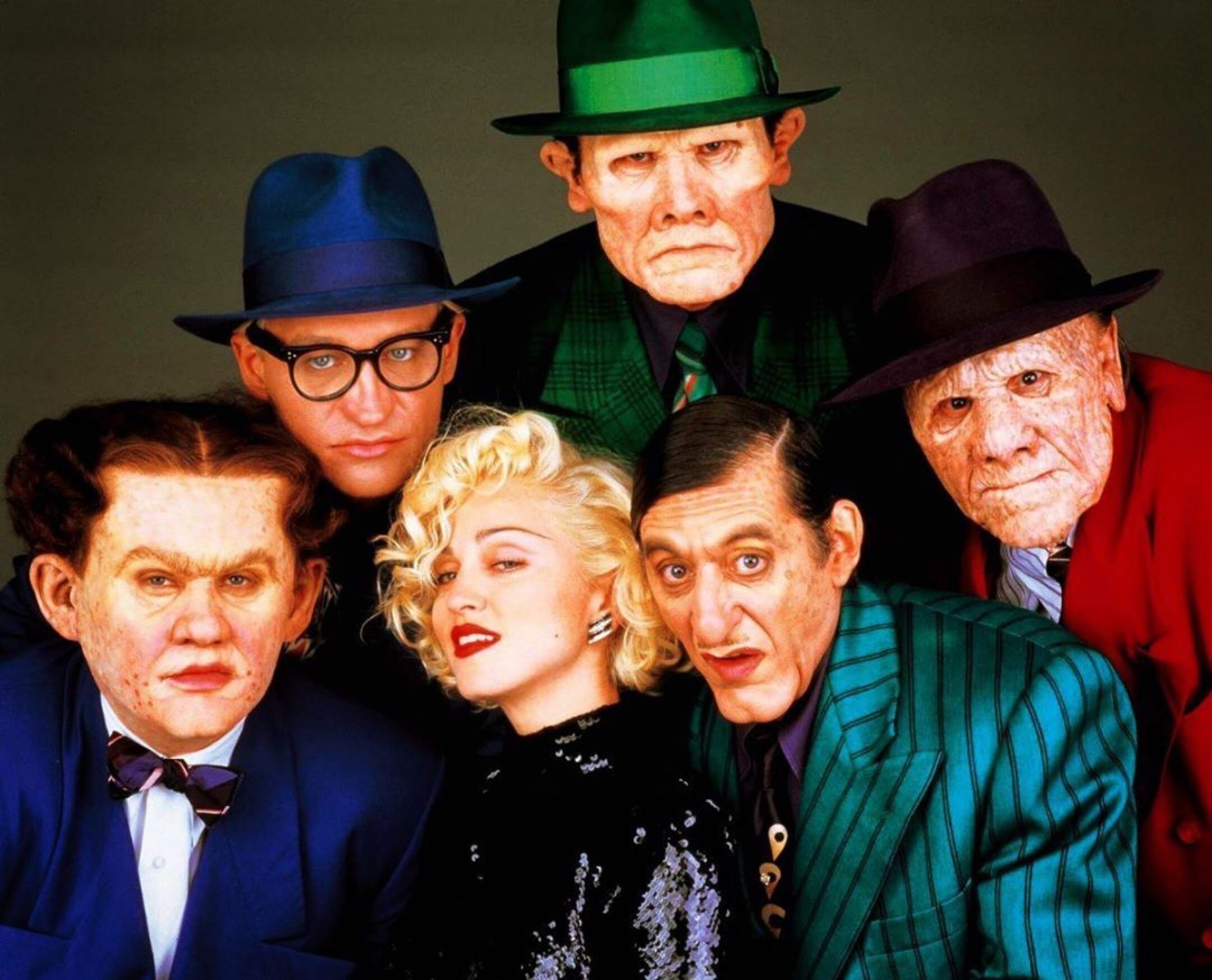Dick Tracy: 30 Years Later
By Eric Grigs | June 15, 2020
Hold onto your yellow fedoras and raincoats, because June 15, 2020 marks the 30th anniversary of Warren Beatty’s Dick Tracy opening in theaters nationwide. Full disclosure: as a kid, I actually had a movie-merchandise yellow Tracy hat and proudly paraded all over the MGM/Hollywood studios park at Disney World in 1990 wearing it. (Was I always deeply uncool? Or too cool? Hard to tell.)
That’s a good entry point for discussing Dick Tracy’s place in movie history, because in advance of its premiere, Disney was cranking up the promotional and merchandising machine, complete with t-shirts and action figures, in preparation for the next Batman. Tim Burton’s reimagining of that character for the big screen had been an unrelenting juggernaut in 1989, and a year later, Disney was sure it had the next big hit on its hands. It actually was the ninth highest grossing film of the year, however $162 million sounds like small potatoes today, in comparison to what recent Marvel comic book blockbusters bring in regularly. When the final tally came in, studio head Jeffrey Katzenberg said they actually lost money on Dick Tracy and it “may not have been worth it,” even with overseas and subsequent home video take.
But apart from the hype and dollar signs, what about the film itself? I recently gave it another watch—and of course, acknowledging my heavily skewed nostalgic perspective—three decades later, I’m still inclined to agree with Roger Ebert’s estimation of it as “one of the most original and visionary fantasies I’ve seen on screen.” Taking its cues from the original Chester Gould comic strips, the movie’s art direction uses bold primary and secondary colors from newspaper printing. It’s also likely one of the last films shot entirely on a soundstage with liberal use background matte paintings—and instead of this being a deficiency, it’s actually a strength. Besides the cops and robbers subject matter and 40s styling that gives the film an old Hollywood feel, its world is somehow displaced from time by the garish colors and painted settings, in a way that gives a whole different reality that’s even unlike perfected CGI environments of today.
Speaking of Hollywood, Beatty must have called in quite a number of favors, because all the A-listers are here: Al Pacino as the main villain “Big Boy” Caprice, supported by Dustin Hoffman, Paul Sorvino, and Dick Van Dyke, alongside veteran character actors Charles Durning, Seymour Cassel, Glenne Headly—and even rising stars for the time like Kathy Bates and Catherine O’Hara. James Caan even makes a very brief but memorable appearance. Most of the actors who play villains are obscured under prosthetics and makeup that’s a delight to behold. It doesn’t shy away from matching the over-the-top looks of their comic counterparts in favor of giving them a “grounded” or realistic treatment. (See Exhibit A: Little Face, mere minutes into the film.)
And then there’s Madonna—who reportedly worked for scale—as Breathless Mahoney, the femme fatale and bombshell lounge singer. For those who think she can’t carry a tune outside of simple pop music, she belts out several original songs by Stephen Sondheim—and everyone knows the lyrical gymnastics he writes aren’t easy. “Sooner or Later” would go on to win the Academy Award for Best Original Song.
Madonna released a soundtrack inspired by the movie, nodding to golden era of Hollywood. A lesser known album entry in her career, I’m Breathless spun off one of her biggest hits, “Vogue.” She followed it with her Blond Ambition tour, which began before the movie premiered and where many North American audiences were introduced to Tracy-themed content. Writer Drew Mackie has a great, detailed take on this pop culture oddity, noting the tour’s segment “was great marketing for the film, of course, but it also meant that the first glimpse of Dick Tracy was unusual, sexy and overtly gay—in short, pretty on-target for Madonna.” Concert-goers were treated to a chorus line of yellow trenchcoated Dicks who later paired off with each other, as the remixed track “Now I’m Following You” repeated Dick’s name suggestively, soon revealing just briefs under their coats. Watching a clip of it now, it’s a wonder Disney would allow such leeway in the depiction of a tentpole franchise’s character. It really has to be seen to be believed. But I suppose the powers that be figured Madonna fans and kids going to the summer movie weren’t much of a crossover.
Which just goes to highlight a question that many have about the film’s tone. Was Dick Tracy ever a kid’s movie? (The year before, there was also a debate on whether Batman was too dark and too violent for children.) Not to be the morality board here, but plenty of the scenes aren’t traditional family-fare. Big Boy slaps around women. Madonna’s boob makes an unexpected guest appearance. There are as many guns and stylized shootings as a Guy Ritchie movie. In the spectacular final battle, a badass Tracy grabs a tommy gun and with the help of the rest of the police, they mow down the rogue’s gallery of gangsters in a hail of bullets and explosions, preventing a final getaway (and possibly preventing a sequel—because really, who’s left to fight next time after dispatching so many of Gould’s creations to the gangster afterlife?). It’s telling that the movie was released not under the Disney brand, but rather the Touchstone label, which was created and mostly reserved for its R-rated content.
Another thing that’s jarring watching it 30 years later: while no one would be in favor of not policing gangsters and racketeering, the outside-the-law tactics Tracy sometimes employs feels not just out of step with time, but also out of sync with the lighthearted bloodless violence and camera’s sped-up punches that came in the first part before the big shoot out. (To be fair, even this “last stand” scene is tame by today’s standards of violence.) Setting the ending aside, Dick Tracy and the boundless optimism of the following year’s The Rocketeer might have heralded the last bright, good vs. bad adventures before the descent of comic book movies into more serious, complex anti-hero and sympathetic villain territory that Batman began—something this genre has never quite recovered from.
Warren Beatty nails the square-jawed hero role. His always honest, can’t be bribed, bumbling in love portrayal of Tracy is cut from the same pattern as Christopher Reeve’s Superman. Beatty was criticized at the time for being too old to play the hero (he was 52), but he refused to relinquish his grip on the character—something that still continues 30 years later.
If Dick Tracy is ever going to grace the silver—or even the small—screen again, Beatty will be involved. After the movie’s box office underperformance, Disney had little interest in a sequel, but Beatty had always planned on one and worked it into the rights he originally secured from Tribune Media Services. In the decades that followed, Tribune and Beatty remained locked in legal battle over the character. Due to a “use-it-or-lose-it” clause, a judge eventually ruled in Beatty’s favor because he produced a strange TCM special, where he appeared in costume and in character as Tracy being interviewed by Leonard Maltin. This satisfied Beatty’s contractual requirement to demonstrate the viability of the character, the public’s interest in it, and his intention to produce new material with the property.
In many ways, I’m glad 1990’s Dick Tracy hasn’t been rebooted and updated since. This movie is a visual confection and comes so close to perfection that I feel strangely protective of it too, just like Beatty. I don’t want a more gritty take. Maybe a Bruce Timm animated version could be fun? But then again, I’d probably just rather re-watch this movie that’s caught in between eras—one foot in old Hollywood, one stepping into a darker future for superheroes that frankly needs this Dick Tracy more than ever. If we ever see another film incarnation of Tracy (or even Beatty’s long talked about self-produced sequel), it likely won’t have nearly as much charm as this. Breathless and 88 Keys sing, “what can you lose?” Well, after revisiting 1990’s matte paintings, practical effects, soundstage filmmaking, classic acting that transcends oddball makeup and costuming—I guess the answer to that is: quite a lot.
Eric Grigs is a pop culture writer, artist, and co-host of the Pop Trash Podcast.



